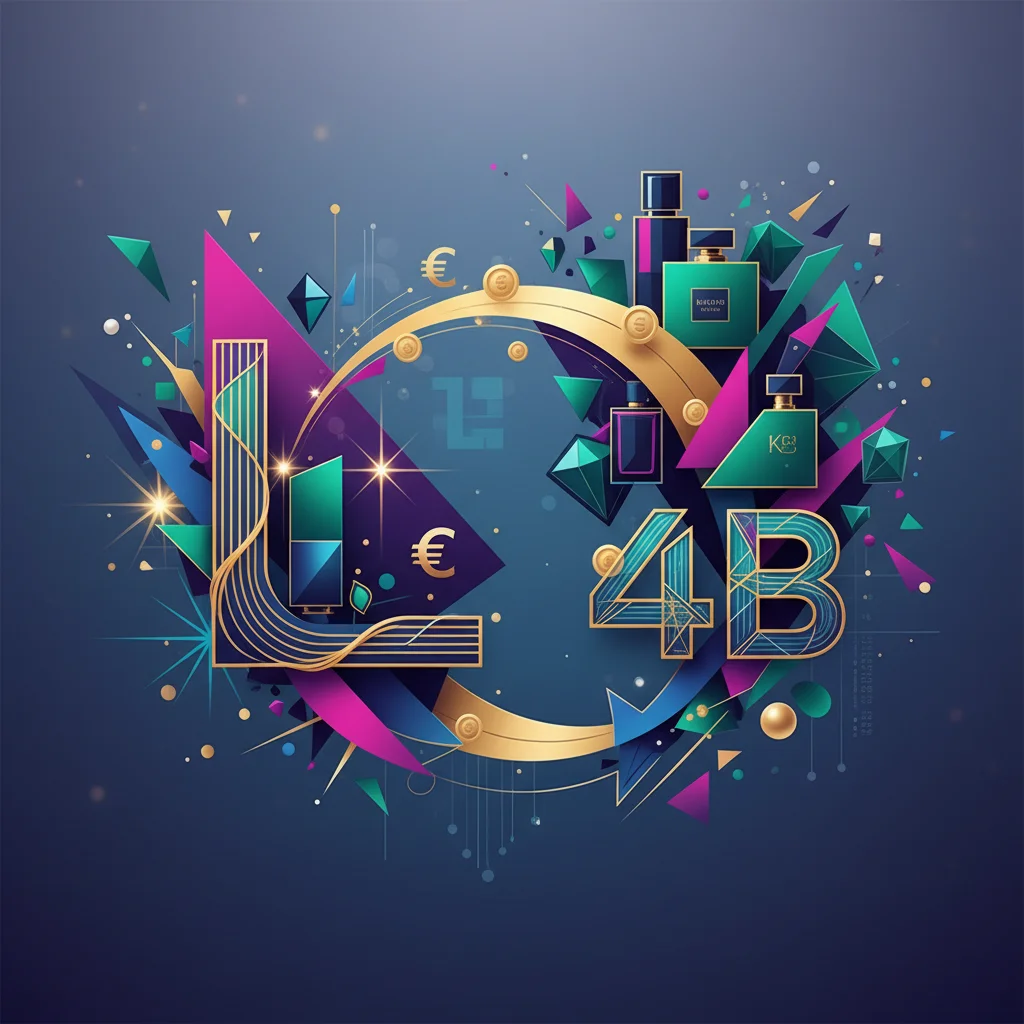
The €4 Billion Beauty Gambit: Why L’Oréal’s Acquisition of Kering’s Luxury Brands is a Market-Defining Move
In a blockbuster deal that sent ripples across the worlds of high fashion and high finance, French luxury group Kering has agreed to a landmark €4 billion sale of its beauty division to cosmetics giant L’Oréal. The transaction includes the coveted rights to develop and market beauty products for some of the most prestigious names in fashion: Gucci, Bottega Veneta, and Balenciaga. This isn’t merely a corporate reshuffle; it’s a strategic masterstroke that redefines the competitive landscape, offering profound lessons on corporate strategy, the economics of luxury, and the future of investing in the consumer goods sector.
For investors, business leaders, and anyone with a pulse on the global economy, this deal is a critical case study. It signals a major consolidation in the resilient luxury market, reflects a strategic pivot by Kering to double down on its core business, and showcases L’Oréal’s aggressive ambition to cement its dominance. Let’s dissect the anatomy of this transaction, its far-reaching implications, and what it signals for the future of finance and brand power.
The Anatomy of a €4 Billion Deal
At its core, this acquisition is about unlocking latent potential. While Kering has made strides in developing its own beauty lines, the reality of the modern cosmetics industry is that scale is king. Competing effectively requires colossal investment in research and development, a global marketing machine, and an intricate distribution network—areas where L’Oréal is the undisputed global leader. The sale hands over the reins of these high-potential beauty brands to a specialist uniquely equipped to turbocharge their growth.
To understand the value proposition, let’s look at the assets L’Oréal is acquiring. This table breaks down the strategic value of each brand within the portfolio:
| Brand | Current Status in Beauty | Untapped Potential & Strategic Value for L’Oréal |
|---|---|---|
| Gucci | Already an established and successful player with a popular makeup line and fragrance collection. It serves as the cornerstone of the acquisition. | L’Oréal can leverage its R&D to expand into high-performance skincare and broaden the makeup range, while using its distribution to penetrate emerging markets more deeply. |
| Bottega Veneta | A niche, ultra-luxury fragrance presence. The brand’s “quiet luxury” ethos is currently a major trend. | Represents a massive opportunity in artisanal perfumery and minimalist, high-end skincare, appealing to a sophisticated consumer base that shuns overt branding. |
| Balenciaga | Limited beauty presence, primarily through sporadic fragrance launches. Known for its edgy, avant-garde fashion. | Offers a blank canvas to create a disruptive, trend-setting beauty line that captures the Gen Z market, similar to the success of LVMH’s Fenty Beauty with its cultural relevance. |
The €4 billion price tag reflects not just the current sales of Gucci Beauty but the immense future revenue streams L’Oréal’s platform can generate from all three brands. For L’Oréal, this is a strategic purchase of future growth, funded by the robust cash flow of its existing empire.
The Gulliver Effect: How a Thousand Legal Threads Could Tie Down the US Economy
Kering’s Strategic Pivot: A Masterclass in Core Competency
For Kering, this sale is a bold declaration of strategic focus. While building an in-house beauty division was an ambitious goal, the move to sell represents a pragmatic acknowledgment of the group’s core strengths: high fashion, leather goods, and jewelry. The immense capital and specialized expertise required to compete with beauty titans like L’Oréal and Estée Lauder would have diverted significant resources from these core operations.
This decision has several powerful financial implications for Kering and its position on the stock market:
- Massive Cash Infusion: The €4 billion in proceeds provides Kering with a formidable war chest. This capital can be deployed to reduce debt, fund strategic acquisitions in its core luxury segments, or return value to shareholders through dividends and buybacks.
- De-risking the Business: Kering eliminates the execution risk associated with scaling a global beauty operation from a relatively nascent stage, allowing management to concentrate on what they do best. According to a Bain & Company report, the luxury beauty market is intensely competitive, and this move allows Kering to benefit from its growth without bearing the direct operational risks.
– Improved Margins: By divesting a capital-intensive, lower-margin business (relative to its core fashion operations), Kering can improve its overall profitability profile, a metric closely watched by investors.
From an investing perspective, Kering becomes a “purer” play on high-end fashion and accessories. This clarity of focus is often rewarded by the market with a higher valuation multiple. The move is a classic example of strategic capital allocation—selling a non-core asset at a premium to reinvest in areas of proven competitive advantage.
L’Oréal’s Grand Design: Building an Unbeatable Moat
If this deal is a strategic pivot for Kering, it’s a strategic conquest for L’Oréal. The world’s largest beauty company is not just adding brands; it’s acquiring cultural capital and filling strategic gaps in its already dominant portfolio. L’Oréal’s Luxe division, which includes brands like Lancôme, Yves Saint Laurent Beauté, and Armani Beauty, is a revenue machine, reporting over €14 billion in sales annually.
The addition of Gucci, Bottega Veneta, and Balenciaga accomplishes three key objectives:
- Strengthening the High-Luxury Tier: Gucci provides immediate scale to compete directly with Dior and Chanel (privately held) in the makeup and fragrance arena. Bottega Veneta and Balenciaga offer entry points into niche, but highly profitable, segments of the market.
- Capturing a Broader Demographic: From Gucci’s broad appeal to Balenciaga’s Gen Z magnetism and Bottega Veneta’s sophisticated minimalism, these brands allow L’Oréal to target a wider spectrum of luxury consumers.
- Leveraging Synergies: L’Oréal’s global R&D labs, immense marketing budget, and unparalleled supply chain and distribution network can plug directly into these brands. This operational synergy means they can launch better products, faster, and in more markets than Kering ever could, dramatically accelerating their growth trajectory.
This acquisition is a clear signal to the market and competitors like Estée Lauder that L’Oréal intends to aggressively expand its share of the high-margin luxury beauty space, a cornerstone of the modern economy‘s consumer discretionary sector.
Steel and Sovereignty: Decoding the UK-EU Tariff Standoff and Its Impact on the Global Economy
Wider Implications for Finance, Technology, and the Economy
A deal of this magnitude transcends the beauty industry, offering a lens into broader trends in global finance and technology.
The transaction itself is a testament to the sophisticated machinery of modern corporate banking and M&A advisory. But looking deeper, the strategy reflects how technology is shaping consumer industries. L’Oréal’s success is built not just on chemistry, but on data. They will use advanced analytics and financial technology tools to dissect consumer trends, personalize marketing, and optimize their e-commerce channels for these newly acquired brands.
Furthermore, the issue of authenticity and provenance is paramount in luxury. While not a direct part of this deal, technologies like blockchain are increasingly being explored in the sector to provide transparent supply chains, verify product authenticity, and combat the multi-billion dollar counterfeit market—a problem that plagues both fashion and cosmetics. L’Oréal’s scale allows it to be a leader in adopting such innovations to protect the integrity of its new crown jewels.
For those involved in stock trading, the post-announcement period will be critical. Analysts will be modeling the financial impact on both companies, adjusting their earnings-per-share forecasts, and debating the long-term value creation. The deal reinforces the idea that in today’s complex global economy, specialization and focus often outperform broad diversification, especially when a specialized partner can unlock greater value.
The .2 Trillion Typo: Unpacking the Monumental Foreign Investment Bet on America
Conclusion: A New Chapter in Luxury
The €4 billion sale of Kering’s beauty division to L’Oréal is far more than a simple transaction. It is a defining moment of strategic clarity for two of Europe’s most influential companies. Kering gains financial firepower and a laser focus on its core fashion and jewelry empire. L’Oréal solidifies its reign over the luxury beauty market, acquiring brands with immense cultural cachet and global growth potential.
For the observer, it’s a powerful lesson in modern capitalism: know your strengths, understand the value of scale, and don’t be afraid to make bold moves to secure your future. This deal will not only reshape the aisles of department stores but will also serve as a key reference point in business school case studies and investor presentations for years to come, illustrating the intricate dance of branding, economics, and high-stakes corporate strategy.


